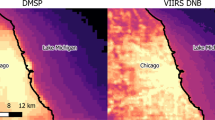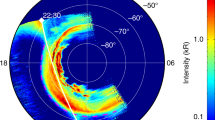Abstract
THE diurnal variation of auroral incidence for Scott Base (New Zealand) and Hallett Station (United States–New Zealand) during the International Geophysical Year is shown in Fig. 1A. Curves derived from analyses of concurrent visual and all-sky camera observations are shown separately. The visual curves are based on observations during all hours which haveor less cloud cover and the all-sky camera curves on photographs in which the Southern Cross is visible (exposures: Scott Base 20 sec, Hallett Station 15 sec, on Tri-X film). The auroral frequencies were computed from quarter-hourly data except Hallett Station visual for which virtually continuous observations were used. This higher density and also the greater sensitivity of the visual observations at Hallett Station for displays near the horizon and in the presence of moonlight, twilight, and thin cloud lift the Hallett visual frequencies well above the photographic frequencies. The Scott Base visual curve is indistinguishable from the one obtained at Cape Evans during 1911, a period of sunspot minimum, by the British (Terra Nova) Antarctic Expedition1.
This is a preview of subscription content, access via your institution
Access options
Subscribe to this journal
Receive 51 print issues and online access
$199.00 per year
only $3.90 per issue
Buy this article
- Purchase on Springer Link
- Instant access to full article PDF
Prices may be subject to local taxes which are calculated during checkout
Similar content being viewed by others
References
Wright, C. S., Observations of the Aurora, British Antarctic (Terra Nova) Antarctic Expedition (1910–13).
Hulbert, E. O., Terr. Mag., 36, 23 (1931).
Stagg, J. M., Proc. Roy. Soc., A, 149, 298 (1935).
Davies, F. T., Terr. Mag., 40, 173 (1935).
Author information
Authors and Affiliations
Rights and permissions
About this article
Cite this article
HATHERTON, T., MIDWINTER, G. Diurnal Variation of Aurora and Geomagnetic Disturbance at New Zealand Antarctic Stations. Nature 184, 889–890 (1959). https://doi.org/10.1038/184889a0
Issue Date:
DOI: https://doi.org/10.1038/184889a0
This article is cited by
Comments
By submitting a comment you agree to abide by our Terms and Community Guidelines. If you find something abusive or that does not comply with our terms or guidelines please flag it as inappropriate.



